lighttools_软件-LED反光杯设计
- 格式:pdf
- 大小:1.03 MB
- 文档页数:9

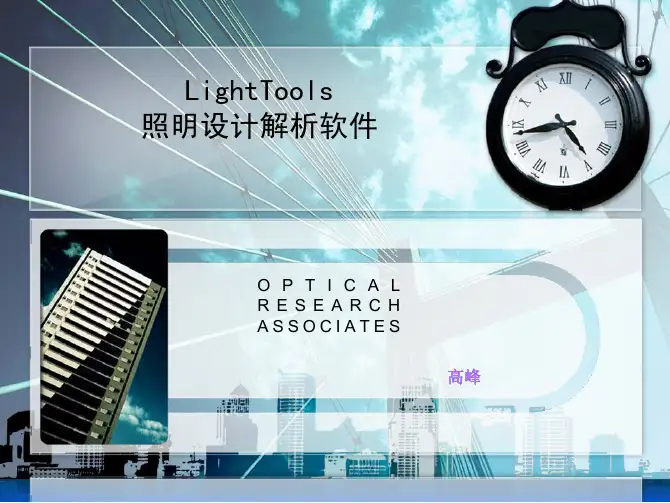
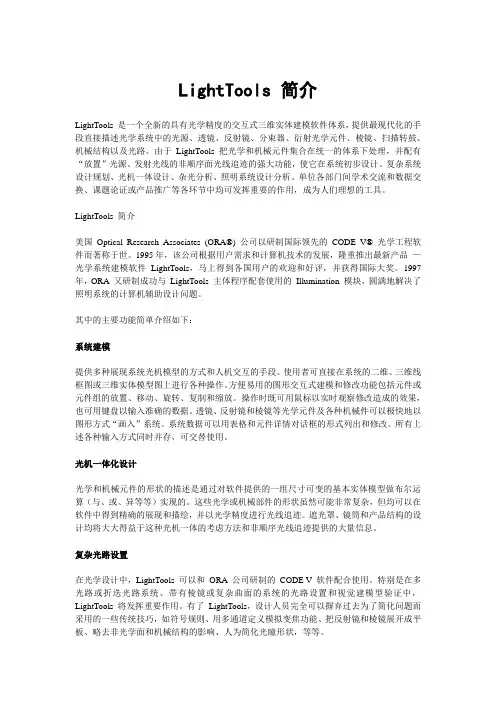
LightTools 简介LightTools 是一个全新的具有光学精度的交互式三维实体建模软件体系,提供最现代化的手段直接描述光学系统中的光源、透镜、反射镜、分束器、衍射光学元件、棱镜、扫描转鼓、机械结构以及光路。
由于LightTools 把光学和机械元件集合在统一的体系下处理,并配有“放置”光源、发射光线的非顺序面光线追迹的强大功能,使它在系统初步设计、复杂系统设计规划、光机一体设计、杂光分析、照明系统设计分析、单位各部门间学术交流和数据交换、课题论证或产品推广等各环节中均可发挥重要的作用,成为人们理想的工具。
LightTools 简介美国Optical Research Associates (ORA®) 公司以研制国际领先的CODE V® 光学工程软件而著称于世。
1995年,该公司根据用户需求和计算机技术的发展,隆重推出最新产品—光学系统建模软件LightTools,马上得到各国用户的欢迎和好评,并获得国际大奖。
1997年,ORA 又研制成功与LightTools 主体程序配套使用的Illumination 模块,圆满地解决了照明系统的计算机辅助设计问题。
其中的主要功能简单介绍如下:系统建模提供多种展现系统光机模型的方式和人机交互的手段。
使用者可直接在系统的二维、三维线框图或三维实体模型图上进行各种操作。
方便易用的图形交互式建模和修改功能包括元件或元件组的放置、移动、旋转、复制和缩放。
操作时既可用鼠标以实时观察修改造成的效果,也可用键盘以输入准确的数据。
透镜、反射镜和棱镜等光学元件及各种机械件可以极快地以图形方式“画入”系统。
系统数据可以用表格和元件详情对话框的形式列出和修改。
所有上述各种输入方式同时并存,可交替使用。
光机一体化设计光学和机械元件的形状的描述是通过对软件提供的一组尺寸可变的基本实体模型做布尔运算(与、或、异等等)实现的。
这些光学或机械部件的形状虽然可能非常复杂,但均可以在软件中得到精确的展现和描绘,并以光学精度进行光线追迹。

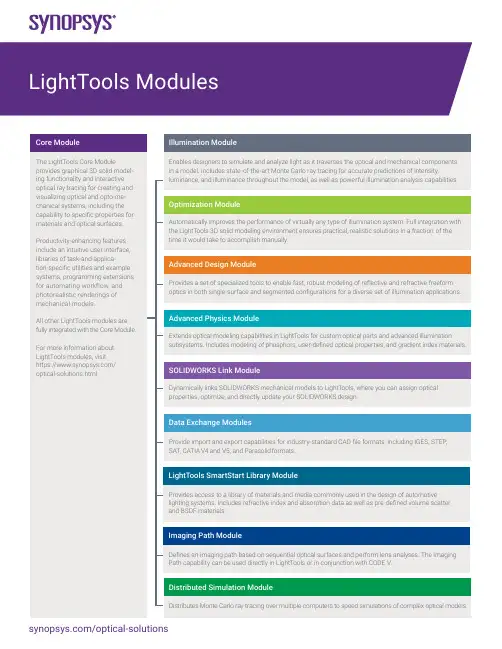
Core ModuleGeometry Creation and Editing• Lens primitives (rectangular or circular apertures)• Spline sweep and patch surfaces• Polyline sweeps and extrusions• Conic trough and revolved reflectors• Cylinders, blocks, spheres, toroids, and skinned solids• Union, intersection, subtraction boolean operations• Object trim operation• Move, rotate, scale, align• Copy, rectangular, and circular pattern copy• Multiple and partial immersion and cementing for solid objects• Pickups for parametric modeling• Grouping of model entitiesOptical Properties• Specular reflection/transmission/TIR with Fresnel losses• Diffuse transmission/reflection• Scatter models: mixed diffuse, narrow angle, and angle of incidence (AOI)• Volume scattering (Mie, user defined)• Scattering aim regions• User-defined coatings• Probabilistic ray splitting and importance sampling• Constant or varying optical density or transmittance vs. length• Index of refraction (constant, interpolated, standard dispersion formulas)• Surface patterns of 2D or 3D elements• Photorealistic rendering (Illumination Module needed for lit appearance)User Interface and Other Features• ActiveX interface for macro programming in MS Excel, VB, VC++, Matlab, Mathematica, and others • OpenGL-rendered graphics• Tabbed windows and editable spreadsheets• Multiple design views and navigation windows• Point-and-click, copy-and-paste, moving and resizing of windows• Extensive help featuresPoint-and-Shoot Ray Tracing• Parallel, diverging, or converging sets of rays• Individual rays, 2D ray fans, 3D ray grids• Sequential and non-sequential ray propagationLibraries• LED sources• Display films• Application and feature examplesIllumination ModulePowerful illumination analysis capabilities, such as photorealistic renderings that show the luminance effects of light sources in the model, simulate real-world conditions and reduce the need for physical prototypes.Illumination Analysis• Photorealistic Rendering• Photometric or radiometric analysis using forward and backward ray tracing• Illuminance, luminance, luminous intensity• Line charts, raster, contour, and surface charts• Colorimetric analysis: 1931 and 1976 CIE coordinates, correlated color temperature• RGB output display, CIE chromaticity chart• Post-processing of output data• Receiver data filtering using over a dozen filter types• Encircled and ensquared energy• Spectral power distribution• Multi-CPU processingSources and Receivers• Point sources• Volume and surface emitters (spheres, cylinders, blocks, toroids)• User-defined spatial, volume, and angular distributions• Source emittance aim regions• Spectral distributions: Blackbody, Gaussian, continuous, discrete, and user defined• Angular and spatial importance sampling• Ray data sources and Radiant Imaging source model support• Surface and far field receivers• Angular and spatial luminance meters• Receiver aperture sub-samplingOptimization ModuleThe Optimization Module gives designers tremendous flexibility to choose from hundreds of system parameters to designate as variables, constraints, and performance criteria in order to achieve the desired system performance.Illumination Optimization• Optimize illumination uniformity and/or flux on a receiver• Match target illumination distributions• Collimate and focus merit functions for non-sequential rays• Lagrange constraint handling• User-defined variables, constraints, and performance criteria• Vary any floating point model parameter• User-defined combinations of parameters• Bounded and unbounded variables• Backlight pattern optimization utility• Parameter sensitivity utility• Point-and-shoot ray merit functionsAdvanced Design ModuleThe Advanced Design Module leverages proprietary algorithms from Synopsys’ LucidShape products that automatically calculate and construct optical geometries based on user-defined illuminance and intensity patterns. This unique, functional approach gives designers the freedom to focus on overall design objectives rather than the implementation details of complex optical components.• Freeform Design features for modeling freeform reflective and refractive surfaces that are automatically shaped to form the resulting light pattern.• MacroFocal Reflector tool for designing multi-surface segmented reflectors, with different spreads for each facet.• Procedural Rectangle Lens tool for designing surfaces with pillowed optical arrays.• LED Lens tool for creating various types of freeform LED collimator lenses.Advanced Physics Module• Designers can take advantage of programming extensions to develop custom optical parts and advanced illumination subsystems using:• Phosphor particle modeling (single and multiple)• Gradient Index (GRIN) materials - used in copiers, scanners, and fiber optic telecommunication systems.• User-defined optical properties (UDOPs) - such as proprietary polarization components, scatterers, coatings, and other specialty optical materials.• Birefringent (uniaxial) materials - used in advanced applications such as AR/VR headsets and biomedical instruments.The results for UDOPs and birefringent materials can be packaged into a portable format and exchanged with your project team, customers, suppliers, and subcontractors.SOLIDWORKS Link ModuleThe SOLIDWORKS Link Module enables you to link SOLIDWORKS 3D opto-mechanical models to LightTools, where you can assign optical properties and use the Optimization Module to optimize your design. This module provides complete parametric interoperability between LightTools models and SOLIDWORKS.Data Exchange ModulesSupporting features for the Data Exchange Modules include the ability to group and simplify imported geometry and perform geometry repairs to maintain CAD model integrity and improve ray trace speed.Translators• SAT version 1.0 through 7.0• STEP AP 203 and AP 214• IGES version 5.3, including surfaces and solids• Parasolid• CATIA V4 and V5 (import and export)• Grouping and simplification of imported surfaces• Geometry repairLightTools SmartStart Library ModuleProvides access to a library of materials and media commonly used in the design of automotive lighting systems. Includes refractive index and absorption data as well as pre-defined volume scatter and BSDF materials.Imaging Path Module• Sequential ray tracing• Paraxial solves• Image path view• Spot diagram and transverse aberration plotsDistributed Simulation ModuleThe Distributed Simulation Module allows you to distribute Monte Carlo ray tracing over multiple computers to speed simulations of complex optical models.©2022 Synopsys, Inc. All rights reserved. Synopsys is a trademark of Synopsys, Inc. in the United States and other countries. A list of Synopsys trademarks isavailable at /copyright.html . All other names mentioned herein are trademarks or registered trademarks of their respective owners.。
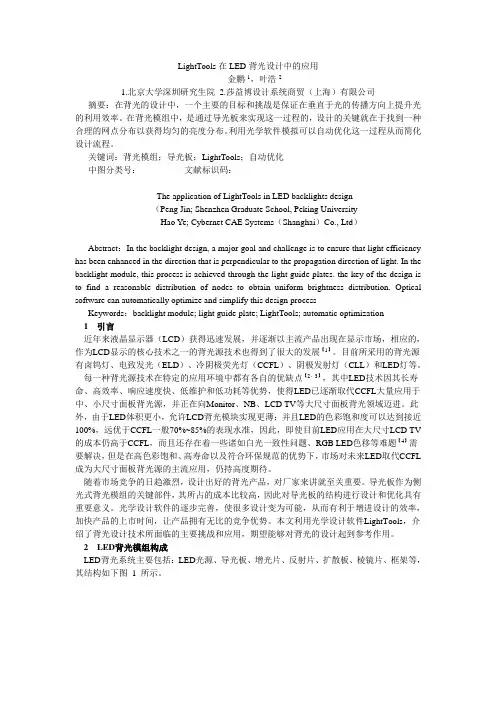
LightTools在LED背光设计中的应用金鹏1,叶浩21.北京大学深圳研究生院2.莎益博设计系统商贸(上海)有限公司摘要:在背光的设计中,一个主要的目标和挑战是保证在垂直于光的传播方向上提升光的利用效率。
在背光模组中,是通过导光板来实现这一过程的,设计的关键就在于找到一种合理的网点分布以获得均匀的亮度分布。
利用光学软件模拟可以自动优化这一过程从而简化设计流程。
关键词:背光模组;导光板;LightTools;自动优化中图分类号:文献标识码:The application of LightTools in LED backlights design(Peng Jin; Shenzhen Graduate School, Peking UniversityHao Ye; Cybernet CAE Systems(Shanghai)Co., Ltd)Abstract:In the backlight design, a major goal and challenge is to ensure that light efficiency has been enhanced in the direction that is perpendicular to the propagation direction of light. In the backlight module, this process is achieved through the light guide plates. the key of the design is to find a reasonable distribution of nodes to obtain uniform brightness distribution. Optical software can automatically optimize and simplify this design processKeywords:backlight module; light guide plate; LightTools; automatic optimization1 引言近年来液晶显示器(LCD)获得迅速发展,并逐渐以主流产品出现在显示市场,相应的,作为LCD显示的核心技术之一的背光源技术也得到了很大的发展【1】。
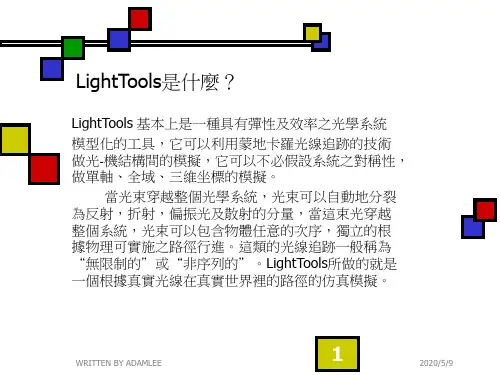
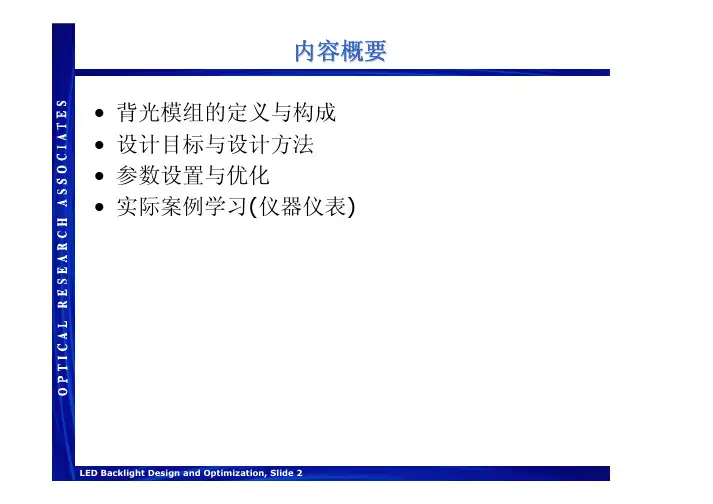
内容概要•背光模组的定义与构成•设计目标与设计方法•参数设置与优化•实际案例学习(仪器仪表)背光模组的定义•一般构成–导光板•通常其材料为塑料•注射成型或印刷式的网点(导光板下表面)–光源和反射罩•(典型光源CCFL and LED )–其他常用的光学元件扩散片(可提高均匀性)反射片•一些元件能否被使用取决于它的尺寸大小和成本以及其它要求Schematic of a typical backlight designLight source Light guideDiffuserReflectorAppliquéTransparency主要设计目标•在垂直光的传播方向上提升光的利用效率Light SourcePreferred direction of light extractionDirection of light propagationLight guideLight extraction from a light guide设计过程: 均匀性•光能量的传播是随导光板的长度变化的-出光的提取效率要随导光板的长度的增加而增加•改变光提取效率的方法:-改变网点密度,网点大小, 网点排布间距Distance from the sourceAvailable powerExtraction efficiencyUniform output背光网点设计•网点模型:印刷式的或注射成型的网点在背光设计中经常用到这两种网点来获得亮度均匀的背光•最佳的设计参数是优化后得到的网点密度分布Pattern Generator+CADIllumination SoftwareOutputOKUnacceptable优化过程通过不断反复调整网点参数进行优化,可以得到最终最佳的亮度与均匀性。
-可以通过做样品或软件模拟来完成光线追迹后输出模拟结果对比输出结果与初始要求网点参数设置计算新的网点更新模型完成OKNot OK网点参数的确定–为避免产生莫尔条纹,每个区域网点的密度是不一样的网点参数确定方法:–定义网点密度为二维网格值–定义网格值•网点的大小为变量•网点的数量和大小都为变量假设给定网点大小与形状通过计算在一个区域内变化网点的数量,得到想要的网点密度–网点密度的变化应该是缓慢而平滑的–人眼对突变是很敏感的,对渐变却不敏感变化网点数量的其他方法–分子动力学方法–多联骨牌法Mosaic Structure withObservableRectilinear Substructure Smooth Variation withObservableRectilinear SubstructureSmooth Variation withSinusoidal Shifts假设给定网点位置排布–经常用的排布一般为六角形通过计算在一个区域内变化网点的大小通过计算在一个区域内变化网点的大小,,得到想要的网点密度–出光的效率和网点排布的密度是成比例的Mosaic Structure using Hexagonal Pattern Smooth Variation using Hexagonal Pattern Smooth Variation using Rectilinear Pattern网点可以在位置的附近移动偏移网点可以在位置的附近移动偏移,,进行随机的变化, 但并不会重叠–也可以对网点的大小进行随机控制Dither X,Y=1,0Dither X,Y=0,1Dither X,Y=1,1Dither X,Y=0,0Dither X,Y=.2,.2Dither X,Y=.5,.5光线追迹与模拟评估此商业照明软件可以对背光进行设计模拟评估–运用蒙特卡罗随机光线追迹的方法来进行光度计算和模拟–模拟结果的精确度取决于光线追迹的数量和分辨率的高低高分辨率低精度低分辨率高精度高分辨率高精度--更多的光线--模拟评估可以使用优化函数进行模拟可以使用优化函数进行模拟,,比较输出结果与要求比较输出结果与要求,,进行评估-可使用优化函数限定统计噪声的最小值•当达到设计目标时可以中止优化函数•可增加光线的数目MF = ∑W i 2(V i -T i )2W i = Weight of i th MF item V i = Current Value of i th MF item T i = Target of i thMF itemLuminancewith 10,000 RaysLuminancewith1,000,000 RaysMF = ∑W i 2(V i + ∈i -T i )2MF = ∑W i 2(V i -T i )2 +Noise网点优化•BPO 通过改变网点的间距和大小来达到设计的要求•网点优化可以是2维的平面网点也可以是3维的网点•我们可以定义个接收面来接收并计算背光板表面的亮度和照度BPO 自动优化网点的过程•BPO 提供有效的优化网点的过程方法案例1: 印刷式导光板的网点优化在开始的时候使用均匀的印刷式网点进行优化得到合理的网点参数Small Source(e.g., LED)2D Display案例2: 注射成型网点的优化–网点大小相同,对排布的位置做优化处理来提高光的利用效率–这个例子是使用注射成型的网点进行优化LEDStartFinalTexture Density Output案例3: 两个LED, 非对称排布•使用注射成型的网点排布•两个LED–LED 采用非对称排布LEDsStartFinalTexture Density Output案例4: 两个LED, 对称排布•使用注射成型的网点排布•两个LED–LED 采用对称排布LEDsStartFinalTexture Density OutputSetupBitmap AppliquéSide ViewTop ViewLEDTextureAcrylic Light PipeBlue Filteron kph Appliqué•如下位图是作为优化的目标illuminance inthe blackregionsOptimization Results15 minutes2.33Ghz processor100,000 rays/iteration Iteration 1Iteration 2Iteration 3Iteration 4Iteration 5Iteration 6•模拟结果Illuminance Chart (1M rays) PhotoRealistic Rendering (100M rays)亮点边缘照明不足•需要新的目标区域设定全覆盖整个面积原有仪表盘结构新的仪表盘结构•最后的结果Photorealistic Rendering (100M rays)结论•网点的优化和模型设置及参数类型选择有紧密联系•介绍了用LightTools 进行设计和分析的一个汽车仪表盘背光的例子。

光电工程实践—照明系统光学设计院系:年级专业:姓名:学号:指导教师:职称:2015年6月一、课程设计的目的、任务与要求目的:使学生掌握照明系统设计的基本知识,培养学生进行照明系统设计的技能,通过该课程设计,要求学生会对照明系统进行初始设置、物体模型的建立、光源的设置、进行一些简单的照明系统的设计。
任务:将学生已有的一些光度学、LED相关的知识,结合照明设计的学习,融合到一些简单的照明系统的设计中来,完成一些简单的照明系统设计。
要求:掌握和照明系统设计相关联的一些基本理论知识,掌握照明设计软件的使用方法,要求会根据给定的任务进行实际设计并对照明系统进行优化。
二、课程设计的设计目标1、利用lighttools设计一个矿灯反光杯,用于在矿灯前方形成集中的光斑以照明。
LED光源发光全角度为170度;反光杯内表面反射,孔径为78mm,在距离光源1000mm处形成100mm左右的圆形光班。
2、设计一个TIR透镜,透镜可以对小角度的光线进行处理,从而减小LED发光角度,实现准直均匀照明。
三、设计过程3.1矿灯反光杯设计过程3.1.1立方体积光源尺寸0.2*1*1;坐标位置(0,0,0)角度(0,0,0),Z坐标为0;出射度100lm;定位面:下角度85°,由发光全角度170°决定的。
3.1.2通过单片式镜头设计反光杯放置平板光学元件坐标(0,0,-10)角度(0,0,0);反光杯在光源左侧,即坐标-10位置;平板为直径为78mm的圆形,与孔径值是一样的;厚度0.1mm即可将其后表面设置为二次曲面面型,曲面系数C为-1,半径给初始值R为15,凹面;将后表面的光学属性设置为简单反射镜,使反光杯的内表面反光;将边的光学属性改为平滑光学,使边透明,方便在3D图形中看清元件的结构,如图3-1a。
接收表面建立虚拟表面,其坐标为(0,0,1000)角度为(0,0,0);接收面为半径为60mm的圆形,添加接收器。

LED的制作和模拟一、设计前的准备工作1、单位的修改和常用参数的选择在Edit菜单下Preferences面板中,General Preferences是对工作环境进行基本的设定,这里主要有两点:第一,设定设计过程中光学元件的单位,在System属性里Unit包含了纳米、微米、毫米、厘米、米、英尺单位,设计者可根据自己的要求设定单位,一般设置为millimeter;第二,光学元件的半径模式Radius Mode,设计者也可根据自己的喜好设定不同的显示模式,在下面的设计中选择Radius。
其它的属性也可根据设计的需要修改。
2、确定即将建立的LED光源的属性,为方便仿真时考查其各方面性能,最好在设计之前先确定LED光源的自身参数,包括功率、光通量、配光曲线、光谱特性等反映LED发光特性的基本参数。
例如功率为3W。
二、光源的建立1、光源尺寸和坐标的设定这里采用发光面设计LED,如图用柱形工具surface拖动,绘制LED并将其坐标属性和几何尺寸定义如下:2、发光面和辐射角度的设定选中刚刚建立的发光面,查看其属性,可以看到,在frontsurface、rearsurface、cylindersurface 三个面的emittance属性中emit rays from surface单选框均被选中,意思是:整个圆柱的表面都是发光面,不太符合LED的设计要求,这里仅让光线从rearsurface发出,其它两个表面的发光属性处于未选中状态,这样发光面即被确定。
下面确定从发光面发出光线的立体角,选中LED在其属性中有Aim sphere 属性对话框,设置如下:意思是,从表面发出光线的半立体角为30度,立体角为60度!3、建立光源的光谱特性和照度配光曲线为了方便比较,这一步暂时放在后面。
4、建立LED聚光镜,通常LED光源前面要加一个球状的聚光和保护镜,用透镜工具建立一个半球状透镜,坐标和几何参数设置如下:前后两个表面曲率半径设置如下:边缘光学属性设置为:Transmitted rays only设置完毕后如图所示:三、光源底座的设计,这是一个对LED的修饰,设计者可根据自己需要添加。

使用LightTools 設計反射設計反射罩罩LightTools 能夠用來設計和分析多樣化照明系統的性能。
最近,北美的Yorka 把LightTools 用於重新設計一個分段式反射罩的停車燈。
透過LightTools 精準的分析原始設計的發光强度和照明分佈分析,我們能夠矯正設計上的問題、符合SAE 的標準以及建構一個令人滿意的原型。
這份文件敘述如何達到重新設計的目的。
分析分析原始設計原始設計第一步是在最初的原型中模擬原始的系統去重現這些問題來觀察。
這個分段式停車燈反射罩原始的幾何物件是使用IGES 輸入功能來輸入到LightTools 裏(見圖1)。
接著3157的電燈泡被加入到各個區域。
在圖2上所示是一個近場的3157燈泡模型。
另外,設定了反射表面的特性和增加兩個接收器來進行照明分析。
一個接收器是測量遠場的發光强度,另一個是表面接收器測量打在尾燈外部透鏡上的照明分佈。
原始設計的模擬分析確認了兩個主要的問題:討厭的亮痕:亮點和條紋在透明的尾燈外部被看出。
圖1的模擬顯示出燈絲經由個別的分割區域將光線集中在尾燈外部的觀察面上。
太強的光線:因為有太多的光線集中在尾部,這組車燈的表現無法通過SAE J585尾燈圖2、近場的3157電燈泡模型電燈泡模型::這個燈泡有兩個燈絲燈泡有兩個燈絲,,而每次僅有一個被點亮。
停車燈為主要的燈絲最亮為33MSCP (平均球面燭光强度平均球面燭光强度),),),而尾而尾燈為次要的燈絲僅產生3MSCP 。
圖1、在LightTools 裏建構原始系統裏建構原始系統::使用分段式反射罩的雙功能車燈使用分段式反射罩的雙功能車燈。
分析後發現會有討厭的條紋現象,無法達到SAE J585和J586的規定的規定。
的規格。
當停車和轉彎兩部份都被點亮時,尾燈會輸出超過45燭光的峰值,這個大大的超過SAE 所規定25燭光的最大值。
重新設計重新設計分段式分段式分段式反射罩反射罩原始反射罩的分割區域被重新設計。
DATASHEETIntroductionWhen you are designing illumination optics for medical devices—particularly when modeling scattering properties of biological tissues—it’s important to use specialized light propagation analysis to verify design performance.Synopsys’ LightTools software can help accelerate development of biomedical optics with its analysis and visualization capabilities. LightTools accurately simulates light propagation through biological tissue using optical properties of the media such as absorption and scattering. In addition, LightTools can be used in conjunction with Synopsys Simpleware software to run detailed optical scenarios in 3D anatomical models.Henyey-Greenstein Volume Scattering in LightToolsLightTools supports the Henyey-Greenstein model to define volume scattering properties of a material by providing data for the scatter distance (in terms of mean free path, scattering coefficient, or reduced scattering coefficient), transmissivity, and anisotropy factor (i.e., angular scattering distribution). This volume scattering type, which is useful particularly in the biomedical field for modeling tissue, has the advantage of using only one variable to describe the angular scattering distribution. This single variable, a parameter of the Henyey-Greenstein phase function, is based on the average direction that rays willscatter. This variable can be obtained from medical literature to model specific types of tissues.LightTools Co-Simulation with Simpleware SoftwareLightTools can be used with Synopsys Simpleware software to provide simulation data to develop a new generation of light-based technologies, including advanced biomedical diagnostics and treatments.Simpleware software provides a solution for the conversion of 3D image data (MRI, CT) into models for visualization, design, analysis, and simulation via exports to CAD, CAE, and 3D printing. Together, Simpleware software andLightTools can enable real-world optical scenarios to be accurately reproduced in simulation by using detailed models of human anatomy. R&D simulations for medical devices, as well as for consumer products and electronics which optically irradiate the human body, can be achieved through this software partnership. Bespoke anatomical models can also be developed for unique applications and LightTools simulation requirements.Features at a Glance• LightTools software can help accelerate development of biomedical optics with its analysis and visualization capabilities.• LightTools can be used in conjunction with Simpleware software to provide simulation data to develop a newgeneration of light-based technologies, including advanced biomedical diagnostics and treatments.• Synopsys’ expert illumination and optical engineers can help you with your product design needs. Contact us at optics@ for more information.Accelerating Biomedical Optics Design with Light Scattering AnalysisFigure 1: Head models created from image data using Synopsys Simpleware software. Simpleware and LightTools can be used in conjunction to run detailed optical scenarios in 3D anatomical models for biomedical applications.Case Study: Biological Tissues SimulationFigure 1 shows an example human head model created in Simpleware software and imported into LightTools for volume scattering analysis of biological tissues. The model consists of four layers: skin, bone, gray matter and white matter.The optical parameters used for all layers of the model are available in industry literature. Example values are shown in the following table.μsTissue layer Refractive indexμaAbsorption coefficientTo model the media between layers (extracellular fluid), the entire model is immersed in the media with a refractive index of 1.51.A source creates a parallel monochromatic beam with wavelength 750 nm. Figure 2 shows nine receivers included in the LightTools model to register the light irradiance.Figure 3 shows the LightTools visualization of volumetric scattering layers after running the illumination simulation.Figure 2: Receiver locations in LightTools model Figure 3: Illumination visualization resultsFigure 4 shows the registered irradiance on the nine receivers.Logarithmic scaleIrradiance, relative units 1.0E-051.0E-041.0E-031.0E-021.0E-01Figure 4: Irradiance distribution within the head modelConclusionWe have shown that light propagation through various layers of the human head can be achieved using Simpleware CAD data and LightTools biological tissue modeling capabilities. The emerging area of using light for biological and medical monitoring, therapy, and research, as well as wearable biosensor technology product development, can benefit from these design capabilities.Designing Illumination Systems for Medical Devices? Our Expert Engineers Can Help.If your team is strapped for time, Synopsys’ experienced staff of illumination and optical engineers can help you meet your product *****************************************************************.For More InformationVisit /optical-solutions to learn more about LightTools for illumination design and Synopsys’ optical engineering consulting services.Visit /simpleware to learn more about Simpleware software for 3D image data visualization, analysis, and model generation. Contact us at ******************* to get started.©2020 Synopsys, Inc. All rights reserved. Synopsys is a trademark of Synopsys, Inc. in the United States and other countries. A list of Synopsys trademarks isavailable at /copyright.html . All other names mentioned herein are trademarks or registered trademarks of their respective owners.。
LightTools软件在均匀光分布的照明系统设计中的应用胡志威;彭润玲;秦汉;林朋飞【摘要】以模拟单颗LED的均匀配光为例,介绍了LightTools软件在照明系统设计中的应用,以便更进一步地掌握和使用LightTools软件.文中借助LightTools软件,在单颗LED上建立反光杯模型,在反光杯出光口建立透镜阵列,并在目标照射面上建立目标区域的强度网格,通过LightTools软件的优化模块进行优化后,可在目标区域得到均匀的光强分布.利用LightTools 软件进行辅助设计和优化模拟,具有很高的可信度,也可以大大缩短照明设计的周期.%With the simulation of single LED light distribution even as an example, LightTools software in lighting system design of the application is introduced in order to further control and use LightTools software. With LightTools software, a reflector model is established above a single LED component and lens array is made on the exit of the reflector, then an intensity mesh for a certain region of the target surface is established After optimization in LightTools, the intensity distribution can be uniform in the target area. The design and optimization with LightTools demonstrate high credibility, and the lighting design cycle could also be greatly shortened.【期刊名称】《光学仪器》【年(卷),期】2012(034)004【总页数】5页(P49-53)【关键词】均匀光强;透镜阵列;照明设计;LightTools【作者】胡志威;彭润玲;秦汉;林朋飞【作者单位】上海理工大学光电信息与计算机工程学院,上海200093;上海理工大学光电信息与计算机工程学院,上海200093;上海理工大学光电信息与计算机工程学院,上海200093;上海理工大学光电信息与计算机工程学院,上海200093【正文语种】中文【中图分类】TH741.4引言与传统光源相比,LED光源具有寿命长、能耗低、响应时间短等优点,它是21世纪具有竞争力的新型固体光源,正逐渐取代传统光源[1]。